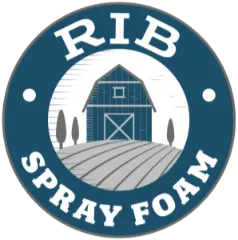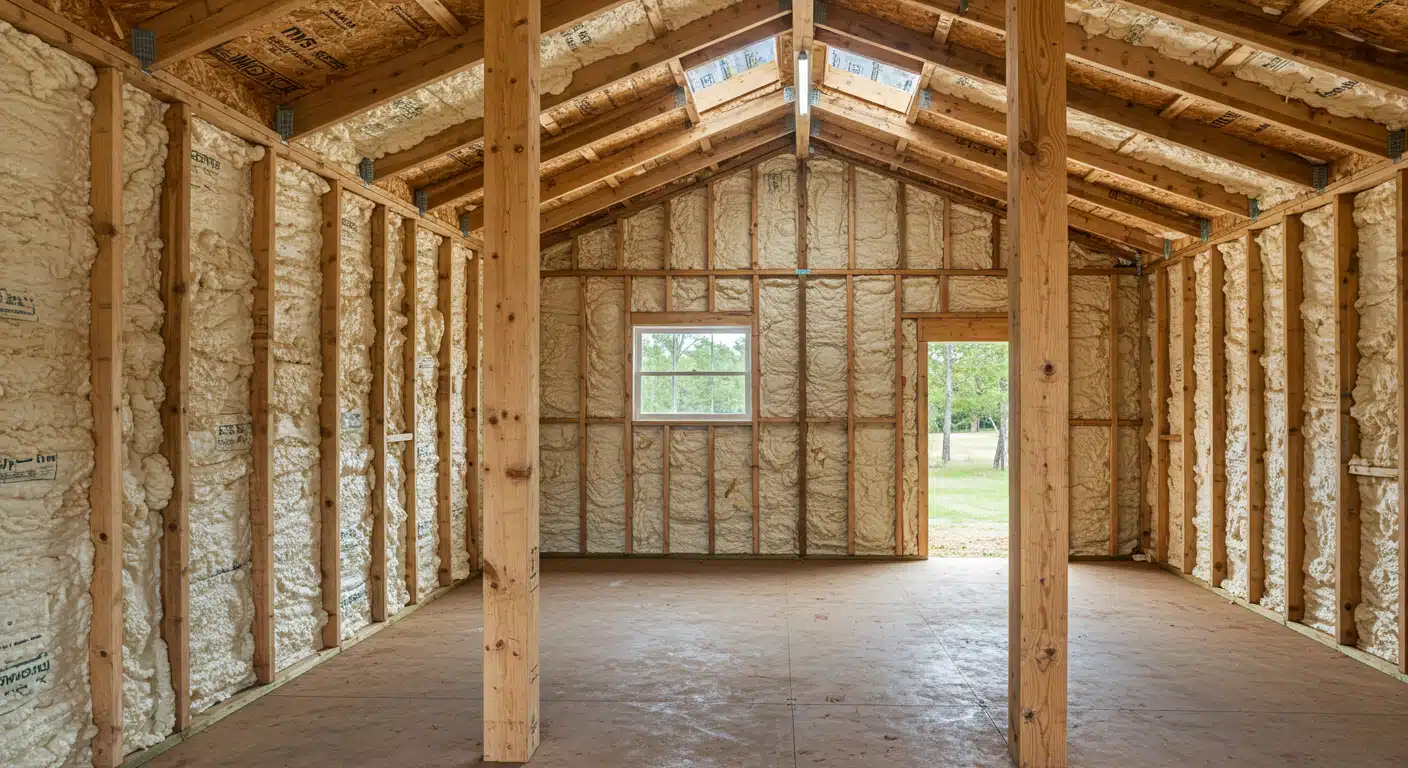If you’re tired of sweating in your pole barn during the summer or shivering through winter chores, you’re not alone. Most pole barns start out as bare-bones structures—great for coverage, but terrible at holding in heat or keeping out the cold. That’s where spray foam insulation steps in.
At Rib Spray Foam Company, we help barn owners across Colorado transform their spaces into comfortable, efficient environments that can be used year-round. Whether you use your pole barn for storage, animals, or a weekend workshop, spray foam can make a world of difference.
Why Spray Foam Works So Well in Pole Barns
Metal buildings are efficient to build, but not great at insulating on their own. Without insulation, heat escapes during the winter and builds up like a greenhouse in the summer. Spray foam creates a sealed envelope inside your barn, sticking directly to walls and ceilings to stop air leaks, drafts, and moisture from creeping in.
Unlike fiberglass or other common materials, spray foam fills every crevice—no gaps, no cold spots. It keeps your space warmer in the winter, cooler in the summer, and far more comfortable overall.
Real-World Benefits You’ll Notice
When you insulate your barn with spray foam, the difference isn’t just on paper—you feel it right away:
- Temperature control: No more freezing mornings or sweltering afternoons.
- Moisture protection: Say goodbye to condensation dripping from the roof.
- Cleaner air: Foam seals out dust, pollen, and pests.
- Stronger structure: Closed-cell foam adds rigidity to walls and roofs.
It’s the kind of upgrade you only wish you’d done sooner.
Why So Many Colorado Barn Owners Choose Rib Spray Foam
We’ve insulated barns from the Eastern Plains to the Rocky Mountain foothills, and every job teaches us something new. We know what it takes to prep and insulate metal buildings properly—and we don’t rush the process.
From taping off electrical outlets to covering tricky trusses, we do it right the first time. You can count on a clean, thorough job that performs well and looks good too.
How to Plan Your Spray Foam Project
Before we ever bring a spray gun on-site, we talk with you about how you use your barn. Is it mostly for storage? Are you heating the space? Housing animals? These answers help us recommend the right insulation approach.
Most of the time, closed-cell spray foam is the best fit. It gives you high thermal performance, repels moisture, and adds structural strength—all in a relatively thin layer. But we always tailor our solution to your specific goals.
Prepping Your Barn: What Happens Before We Spray
Good insulation starts with good prep. That means:
- Checking the building for leaks, rust, or water issues
- Making sure surfaces are clean and dry
- Sealing up problem spots around doors, eaves, and the foundation
- Masking off anything that shouldn’t be sprayed
Taking the time to prep ensures the spray foam sticks properly and performs well for years.
How Long Does It Take?
Most pole barn insulation projects can be finished in one to two days, depending on the size of the space. Spray foam cures quickly, so your barn is back in action the next day. We work fast—but we never cut corners.
Getting to the Tough Spots
Pole barns are full of tricky areas—ridge vents, corners, overhead beams. These are places where air sneaks in and heat escapes. Spray foam excels here because it expands into every space and sticks to almost anything, creating a seamless, airtight layer that holds up over time.
What About the Roof?
A lot of heat loss happens through the roof, especially if you’ve got a metal top with no insulation underneath. We spray foam directly to the underside of your roof panels and in between trusses. This helps prevent heat from radiating in during summer and escaping in winter.
Because spray foam bonds tightly and doesn’t sag like fiberglass, you get full coverage in areas that matter most.
Clean Application. No Mess.
We take pride in keeping your space clean. Before we start spraying, we cover windows, doors, lights—anything that shouldn’t get hit. Our crew is trained to avoid overspray and ensure the final product is neat, even, and effective.
Moisture Problems? Spray Foam Solves That Too.
Uninsulated barns are notorious for condensation problems. When warm air inside hits cold metal walls, you get water droplets—rust, mold, and rot soon follow. Spray foam works as a vapor barrier and air seal in one, stopping condensation before it starts.
Closed-Cell or Open-Cell Foam—What’s Best?
For pole barns, we almost always recommend closed-cell spray foam. It’s dense, water-resistant, and delivers more insulation value per inch. It also adds strength to your structure, which is great in windy areas or with older buildings.
Open-cell foam is softer and more flexible, usually used inside homes—not ideal for barns with metal siding.
Insulation That Protects What Matters
Adding spray foam isn’t just about comfort. It protects everything inside your barn—from tools to equipment to livestock—by keeping temperatures steady and moisture out. It’s a long-term investment in the usefulness and durability of your building.
We’re Ready When You Are
If you’ve been thinking about insulating your pole barn, there’s no better time. We’ve helped barn owners all over Colorado improve their spaces, and we’re ready to help you, too.
Let’s talk about your project. Call us at (970) 518-2883 or email [email protected] for a free consultation.
Frequently Asked Questions
How much will it cost to insulate my pole barn?
It depends on the size, foam type, and how much prep is needed. We offer free estimates.
Can spray foam be used directly on metal?
Yes, with the right prep work, spray foam sticks to metal extremely well.
Will spray foam stop condensation in my barn?
Absolutely. It acts as a vapor barrier and prevents moisture buildup inside.
Is it safe for barns with animals?
Yes. Once cured, spray foam is inert and perfectly safe for livestock.
Do I still need insulation if I’m just using the barn for storage?
Yes. Insulation helps protect your stored items from extreme temperatures and humidity.



